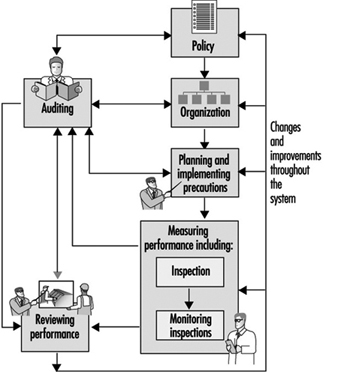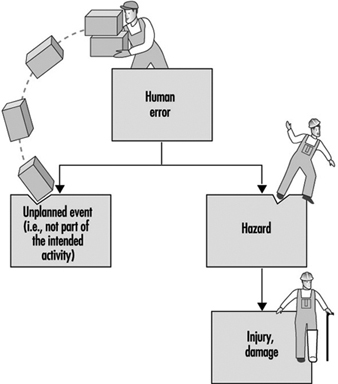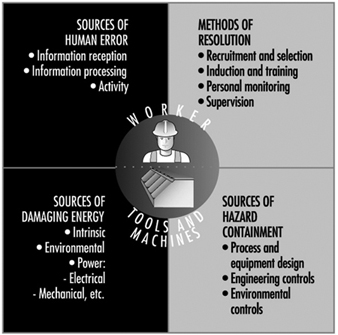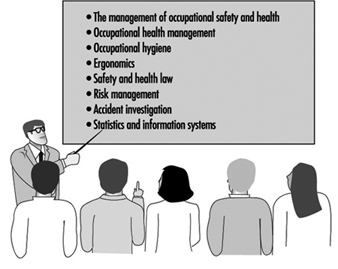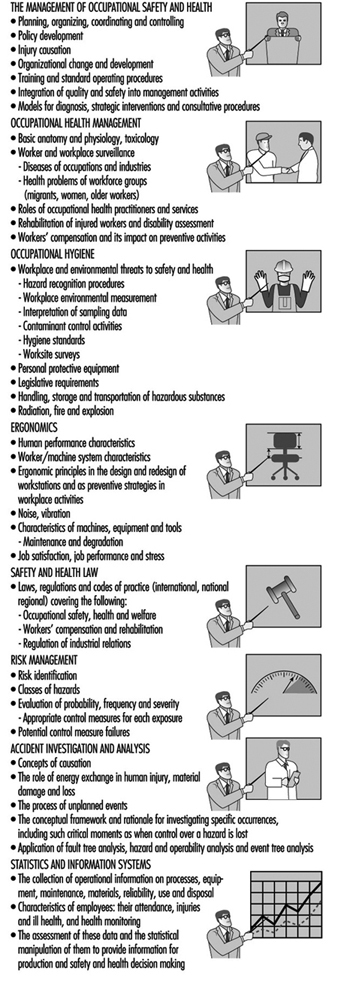Following a brief review of the development of educational contributions to worker health and safety and of the first attempts to establish the foundations of management education, this article will address curriculum development. The two career paths along which future senior managers develop will be considered as an issue relevant to the educational needs of managers. The curriculum content for managerial issues will be set forth first, to be followed by that pertinent to an understanding of injury causation.
Education for occupational safety and health has been directed, in the main, to people such as safety managers and occupational physicians, and more recently, to occupational health nurses, ergonomists and hygienists—people who have been appointed to specialist staff positions in organizations.
The advisory roles of these specialists have incorporated tasks such as the administration of pre-employment medical examinations, health surveillance, monitoring employee exposures to a range of hazards and environmental examination. Their activities moreover include contributing to job and task design in order to adjust engineering or administrative controls by way of minimizing if not eliminating (for example) the harmful effects of postural demands or of exposure to toxic hazards.
This specialist-oriented educational approach has tended to ignore the central fact that the provision of safe and healthy workplaces requires an extraordinarily broad scope of operational knowledge necessary to make them a reality. It must be borne in mind that managers carry the responsibility for planning, organizing and controlling work activities in public and private enterprises across all industry sectors.
Background
During the decade of the 1970s many initiatives were taken to offer study programmes at the tertiary level to provide a professional education with practical training for the range of specialist engineers, scientists and health care workers entering the field of occupational safety and health.
In the 1980s it was recognized that the people most directly concerned with occupational safety and health, the managers, the workers themselves and their associations, were the most significant entities in the move to reduce workplace injury and ill health. Legislation in many jurisdictions was introduced to provide education for workers serving on safety committees or as elected safety and health representatives. These changes highlighted for the first time the very limited education and training facilities then available to managers.
An early initiative to address management education
Several steps were taken to overcome this problem. The most widely known is Project Minerva, an initiative of the US National Institute for Occupational Safety and Health (NIOSH), which represented an early effort to inculcate that body of specific managerial skills which is necessary to ensure workplace safety and which “generally exceeds that which is offered through courses in the traditional business curriculum” (NIOSH 1985). Teaching materials intended to address the more urgent safety and health concerns were provided for business schools. The resource guide comprised instructional modules, case studies and a book of readings. Module topics are listed in figure 1.
Figure 1. Modular curriculum content, Project Minerva resource guide.
The Canadian Society of Safety Engineers has recommended this structure to business schools seeking to incorporate occupational safety and health materials into their curricula.
Fundamentals of Managing: General Rather Than Specific Needs
Any job responsibility entails the acquisition of relevant knowledge and appropriate skills in order to discharge it. Responsibility for managing occupational safety and health within any organization will be placed increasingly upon line managers at each level in the job hierarchy. Associated with that responsibility ought to be commensurate accountability and the authority to command the necessary resources. The knowledge and skills needed to discharge this responsibility form the curriculum for occupational safety and health management education.
At first sight, it would seem necessary that a curriculum of this sort be developed with the aim of meeting all the special demands of the whole range of management functions as they relate to such a diversity of positions as office administrator, nurse manager, operations director, supplies and purchasing superintendent, fleet coordinator and even ship’s captain. The curricula need also, perhaps, address the whole range of industries and the occupations found within them. However, experience strongly suggests that this is not so. The necessary skills and knowledge are, in fact, common to all management functions and are more fundamental than those of the specialists. They are operative at the level of basic management expertise. However, not all managers arrive at their position of responsibility by taking similar paths.
Managerial Career Paths
The usual path to a managerial career is through either supervisory or specialist functions. In the former case, career development is dependent on work experience and job knowledge and in the latter it ordinarily presupposes off-the-job college education and postgraduate study, for example as an engineer or nurse manager. Both streams need to develop occupational safety and health (OSH) skills. For the latter this may be done in graduate school.
It is usual today for successful managers to acquire the degree of Master of Business Administration (MBA). For this reason the Minerva Project directed its attention to the 600 or more graduate management schools in the United States. By incorporating into MBA curricula such aspects of occupational safety and health as were determined to be critical for successful management of the field, it was believed that this material would be integrated into the formal studies of middle management.
Given the extremely high rate of technological invention and scientific discovery, undergraduate courses, particularly in engineering and scientific disciplines, have only limited opportunities to integrate broadly-based safety theory and practice into design, process and operation studies.
Since managerial roles begin fairly soon after graduation for those with specialist education, there is a need to provide the knowledge and skills that will support the safety and health responsibility of both specialist and generalist managers.
It is important that an awareness of the content of any curriculum devoted to occupational safety and health objectives among management be promoted among other personnel having related responsibilities. Thus, the training of such key employees as safety and health representatives should be designed to keep them current with such curricular developments.
Curriculum for Managing Occupational Safety and Health
There are two broad classes of knowledge into which the discipline of occupational safety and health falls. One is that relating to the functions and principles of management and the other deals with the nature and proactive control of hazards. The model of curriculum development set forth below will follow this division. Both the supervisory path to management and the specialist path will require their own particular coverage of each of these classes.
The question of what level of complexity and technological detail needs to be provided to students may be determined by the purpose of the course, its length and the intention of the providers regarding subsequent education and skills development. These issues will be addressed in a later section.
Specifically, curricula should address machinery and plant safety, noise, radiation, dust, toxic materials, fire, emergency procedures, medical and first aid arrangements, workplace and employee monitoring, ergonomics, environmental hygiene, workplace design and maintenance and, most importantly, the development of standard operating procedures and training. This last is an essential component of managerial understanding. Not only must tasks and processes be the subject of operator training but the requirement for continuous improvement of people and processes makes training and retraining the most critical step in improving the quality of both. Adult learning theory and practice needs to be applied in the development of the curricular materials that guide this continuing training process.
The functions and principles of management
The fundamental purposes of management embrace the planning, organizing and control of workplace activities. They also embrace the incorporation of practices which maximize opportunities for workforce participation in goal setting, team operation and quality improvement. Furthermore, successful management requires the integration of occupational safety and health into all the organization’s activities.
It is rare for undergraduate programmes, outside those of colleges of business, to cover any of this knowledge. However, it is a most essential component for the specialist practitioners to have incorporated into their undergraduate study.
Organizational framework
The mission statement, strategic plan and structure set up to guide and facilitate the attainment of the organization’s objectives must be understood by the managers to be the basis for their individual activities. Each division of the organization whether it is a hospital, trucking business or coal mine, will in turn have its own goals and structure. Each will reflect the need to achieve organizational goals, and, taken together, will drive the organization towards them.
Policies and procedures
The primary embodiment of an organization’s goals are comprised by policy documents, the guides for individual employees on specific topics. (In some jurisdictions, the publication of an organization’s overall policy is required by law.) These documents ought to include reference to the range of occupational safety and health programmes designed with regard to the activities and processes which occupy the working time of employees. A sample of some general policy statements might include documents on emergency evacuation, fire fighting, purchasing procedures, injury reporting and accident and incident investigation. On the other hand, specific hazards will require their own process-specific policy materials concerning, for example, hazardous substances management, ergonomic interventions or entry into confined spaces.
After establishing policy, an activity preferably carried out with worker representative participation and union involvement, detailed procedures would then be put in place to give effect to them. Again, participative practices will contribute to the wholehearted acceptance of them by the workforce as a valuable contribution to their safety and health.
A safety and health management system is schematically illustrated in figure 2.
Figure 2. A health and safety management system.
Organizational structures defining key roles
The next stage in the management process is to define an organizational structure which characterizes the roles of key people—for example, the chief executive—and professional advisors such as safety advisors, occupational hygienists, the occupational health nurse, the physician and the ergonomist. In order to facilitate their roles, the relationships of these people and elected safety and health representatives (required in some jurisdictions) and worker members of safety committees to the organizational structure need to be explicit.
The planning and organizing functions of management will integrate structures, policies and procedures into the operational activities of the enterprise.
Control
Control activities—establishing processes and goals, determining standards of acceptable achievement and measuring performance against those standards—are the operational steps which bring to realization the intentions of the strategic plan. They also need to be established through co-determination. The tools for control are workplace audits, which may be continuous, frequent, random or formal.
An understanding of these activities is an important component of a management education syllabus, and skills should be developed in carrying them out. Such skills are as essential to the success of an integrated safety and health plan as they are to the discharge of any other management function, whether purchasing or fleet operation.
Organizational development and curriculum
Since the introduction of new organizational structures, new equipment and new materials is occurring at a rapid pace, special attention must be given to the processes of change. The employees who will be affected by these changes can have a deciding influence on their effectiveness and on the efficiency of the work group. An understanding of the psychosocial factors influencing the activities of the organization must be acquired and skills must be developed in using this knowledge to reach organizational objectives. Of particular importance is the delegation of the authority and the accountability of the manager to work groups formed into autonomous or semi-autonomous work teams. The management education curriculum must place at the disposal of its students the tools necessary to carry out their obligation to ensure not only process improvement and quality but the development of the multiple skills and quality awareness of personnel with which the issue of safety is so closely involved.
There are two further components of the management curriculum requiring examination. One of these is the activity of incident investigation and the other, on which the whole of this activity rests, is an understanding of the accident phenomenon.
The accident phenomenon
The work of Derek Viner (1991) in clearly expounding the significance of energy sources as the potential hazards in all workplaces has defined half of the accident equation. In conjunction with Viner’s work, the contribution of Dr. Eric Wigglesworth (1972) in identifying human error, the crucial element in managing workplace safety activities, completes its definition. An emphasis on the process of each damaging occurrence has been shown by Benner (1985) when considering accident investigation methods to be the most productive approach to managing worker safety and health.
Wigglesworth’s visualization of the sequence of events which results in injury, damage and loss appears in figure 3. It highlights the role of nonculpable human error, as well as the essential element of loss of energy containment and the potential for the injury outcome where this occurs.
Figure 3. The error/injury process.
The implications of the model for management become clear when planning for work processes takes account of the behavioural inputs which affect those processes. This is so in particular when the role of design is given its rightful place as the initiating mechanism for both equipment and process development. When planning takes account both of the design of plant and equipment and of the human factors influencing work activity, coordination and control mechanisms can then be implemented to assure containment of the identified hazards.
A model may be used to illustrate the significance of the interaction between the worker, the equipment, tools and machines employed to further the task objectives and the environment within which the activity takes place. The model highlights the need to address factors within all three elements which may contribute to damaging events. Within the workstation environment, which encompasses the thermal, aural and lighting components, among others, the worker interacts with the tools and equipment necessary to get the work done (see figure 4).
Figure 4. Representation of workstation elements relevant to injury causation and control.
Accident investigation and analysis
Accident investigation serves a number of important functions. First, it can be a proactive process, being used in situations where an incident occurs which results in no damage or injury but where there is a potential for harm. Studying the sequence of events can uncover features of the work process which could lead to more serious consequences. Second, one may gain an understanding of the process by which the events unfolded and thus can identify the absence of, or weakness in, process or task design, training, supervision or controls over energy sources. Third, many jurisdictions legally require investigations of certain types of incidents, for example, scaffolding and trench collapses, electrocutions and failures of hoisting equipment. The work of Benner (1985) illustrates well the importance of having a clear understanding of the accident phenomenon and an effective protocol for investigating injury and damage events.
The nature and control of hazards
All injury results from some form of energy exchange. The uncontrolled release of physical, chemical, biological, thermal, or other forms of energy is a source of potential harm to a variety of workers. Containment by suitable engineering and administrative mechanisms is one essential aspect of suitable control. Identifying and evaluating these energy sources is a prerequisite for control.
A management education curriculum would thus contain topics covering a range of activities which includes establishing objectives, planning the work, developing policy and procedures, undertaking organizational change and installing controls over work processes (and specifically the energy sources utilized in carrying out that work), all aimed at injury prevention. While curricula designed for the technical areas of operations need address only fundamental principles, organizations that make use of very hazardous materials or processes must have in their employ a senior member of management with sufficient training in the specific modes of handling, storage and transport of such technology to ensure the safety and health of workers and members of the community.
Larger enterprises and small business
Managers who work in larger organizations employing, say, a hundred or more people usually have one or only a few functional responsibilities and report to a senior manager or a board of directors. They have occupational safety and health responsibility for their own subordinates and act within established policy guidelines. Their educational needs may be addressed by the formal programmes offered in business schools at the undergraduate or graduate level.
On the other hand, the sole managers or partners in small enterprises are less likely to have had graduate education, and, if they have, it is more likely to be of a technological than managerial sort, and it is more difficult to address their needs for the management of occupational health and safety.
Small business needs
Providing training programmes for these managers, who often work very long hours, has represented a difficulty of long standing. Although a number of large legislative jurisdictions have produced guidance booklets setting out minimum performance stands, the more promising approaches are being made available through industry associations, such as the Ontario Industrial Accident Prevention Associations funded by levies placed by the Workers’ Compensation Board upon all businesses in the given industrial sector.
Syllabus Content
A body of knowledge and skills which addresses the needs of managers at the first-line supervisory level, middle management and senior executives is outlined in figure 5 by topic. Individual short-form syllabuses follow in figure 6. These have been collated from the syllabuses of a number of university graduate study programmes.
Figure 5. Syllabus for an OSH study programme.
Figure 6. Short form syllabuses for an OSH study programme.
The needs of first-line supervisors will be met through the acquisition of knowledge and skills covered by those topics that relate to operational demands. The training of senior executives will concentrate on such topics as strategic planning, risk management and compliance matters as well as initiating policy proposals. The allocation of hours for each course of study should reflect student needs.
Summary
Management education for occupational safety and health demands an eclectic approach to the broadest range of issues. It shares with quality the imperative of being integrated into every management and worker activity, into every employee’s job description and should be a part of the performance appraisal of all.


